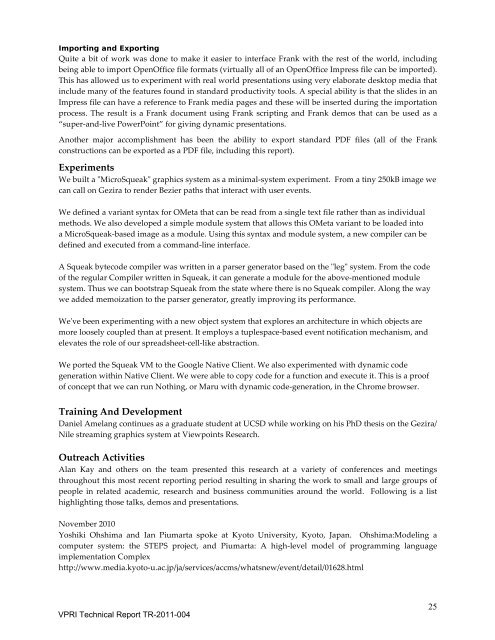Create successful ePaper yourself
Turn your PDF publications into a flip-book with our unique Google optimized e-Paper software.
Importing and Exporting<br />
Quite a bit of work was done to make it easier to interface Frank with the rest of the world, including<br />
being able to import OpenOffice file formats (virtually all of an OpenOffice Impress file can be imported).<br />
This has allowed us to experiment with real world presentations using very elaborate desktop media that<br />
include many of the features found in standard productivity tools. A special ability is that the slides in an<br />
Impress file can have a reference to Frank media pages and these will be inserted during the importation<br />
process. The result is a Frank document using Frank scripting and Frank demos that can be used as a<br />
“super‑and‑live PowerPoint” for giving dynamic presentations.<br />
Another major accomplishment has been the ability to export standard PDF files (all of the Frank<br />
constructions can be exported as a PDF file, including this report).<br />
Experiments<br />
We built a ʺMicroSqueakʺ graphics system as a minimal‑system experiment. From a tiny 250kB image we<br />
can call on Gezira to render Bezier paths that interact with user events.<br />
We defined a variant syntax for OMeta that can be read from a single text file rather than as individual<br />
methods. We also developed a simple module system that allows this OMeta variant to be loaded into<br />
a MicroSqueak‑based image as a module. Using this syntax and module system, a new compiler can be<br />
defined and executed from a command‑line interface.<br />
A Squeak bytecode compiler was written in a parser generator based on the ʺlegʺ system. From the code<br />
of the regular Compiler written in Squeak, it can generate a module for the above‑mentioned module<br />
system. Thus we can bootstrap Squeak from the state where there is no Squeak compiler. Along the way<br />
we added memoization to the parser generator, greatly improving its performance.<br />
Weʹve been experimenting with a new object system that explores an architecture in which objects are<br />
more loosely coupled than at present. It employs a tuplespace‑based event notification mechanism, and<br />
elevates the role of our spreadsheet‑cell‑like abstraction.<br />
We ported the Squeak VM to the Google Native Client. We also experimented with dynamic code<br />
generation within Native Client. We were able to copy code for a function and execute it. This is a proof<br />
of concept that we can run Nothing, or Maru with dynamic code‑generation, in the Chrome browser.<br />
Training And Development<br />
Daniel Amelang continues as a graduate student at UCSD while working on his PhD thesis on the Gezira/<br />
Nile streaming graphics system at Viewpoints Research.<br />
Outreach Activities<br />
Alan Kay and others on the team presented this research at a variety of conferences and meetings<br />
throughout this most recent reporting period resulting in sharing the work to small and large groups of<br />
people in related academic, research and business communities around the world. Following is a list<br />
highlighting those talks, demos and presentations.<br />
November 2010<br />
Yoshiki Ohshima and Ian Piumarta spoke at Kyoto University, Kyoto, Japan. Ohshima:Modeling a<br />
computer system: the STEPS project, and Piumarta: A high‑level model of programming language<br />
implementation Complex<br />
http://www.media.kyoto‑u.ac.jp/ja/services/accms/whatsnew/event/detail/01628.html<br />
VPRI Technical Report TR-2011-004<br />
25


